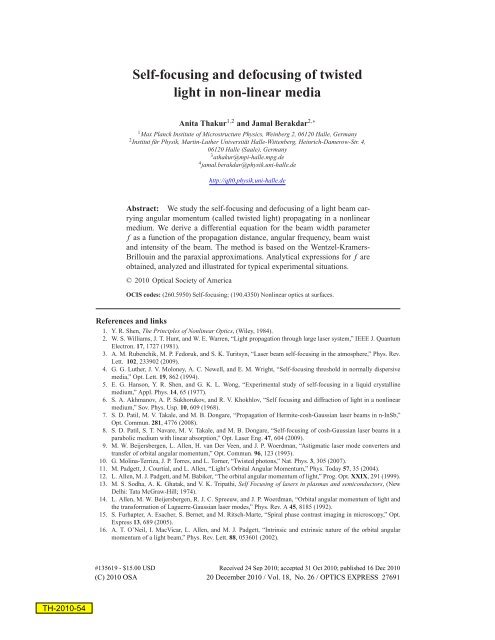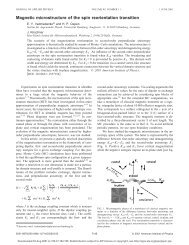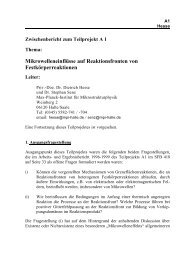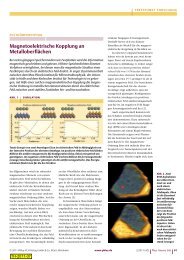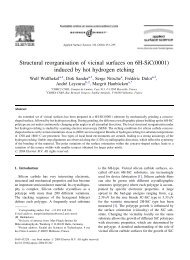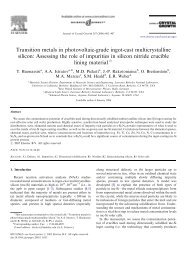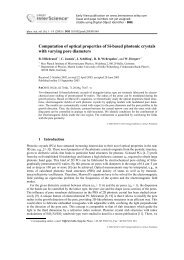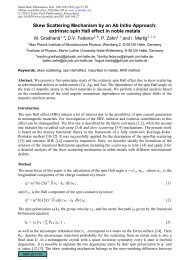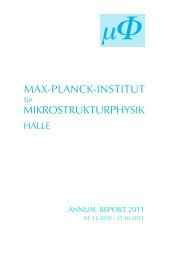Self-focusing and defocusing of twisted light in non-linear media
Self-focusing and defocusing of twisted light in non-linear media
Self-focusing and defocusing of twisted light in non-linear media
Create successful ePaper yourself
Turn your PDF publications into a flip-book with our unique Google optimized e-Paper software.
<strong>Self</strong>-<strong>focus<strong>in</strong>g</strong> <strong>and</strong> de<strong>focus<strong>in</strong>g</strong> <strong>of</strong> <strong>twisted</strong><br />
<strong>light</strong> <strong>in</strong> <strong>non</strong>-l<strong>in</strong>ear <strong>media</strong><br />
Anita Thakur 1,2 <strong>and</strong> Jamal Berakdar 2,∗<br />
1 Max Planck Institute <strong>of</strong> Microstructure Physics, We<strong>in</strong>berg 2, 06120 Halle, Germany<br />
2 Institut für Physik, Mart<strong>in</strong>-Luther Universität Halle-Wittenberg, He<strong>in</strong>rich-Damerow-Str. 4,<br />
06120 Halle (Saale), Germany<br />
3 athakur@mpi-halle.mpg.de<br />
4 jamal.berakdar@physik.uni-halle.de<br />
http://qft0.physik.uni-halle.de<br />
Abstract: We study the self-<strong>focus<strong>in</strong>g</strong> <strong>and</strong> de<strong>focus<strong>in</strong>g</strong> <strong>of</strong> a <strong>light</strong> beam carry<strong>in</strong>g<br />
angular momentum (called <strong>twisted</strong> <strong>light</strong>) propagat<strong>in</strong>g <strong>in</strong> a <strong>non</strong>l<strong>in</strong>ear<br />
medium. We derive a differential equation for the beam width parameter<br />
f as a function <strong>of</strong> the propagation distance, angular frequency, beam waist<br />
<strong>and</strong> <strong>in</strong>tensity <strong>of</strong> the beam. The method is based on the Wentzel-Kramers-<br />
Brillou<strong>in</strong> <strong>and</strong> the paraxial approximations. Analytical expressions for f are<br />
obta<strong>in</strong>ed, analyzed <strong>and</strong> illustrated for typical experimental situations.<br />
© 2010 Optical Society <strong>of</strong> America<br />
OCIS codes: (260.5950) <strong>Self</strong>-<strong>focus<strong>in</strong>g</strong>; (190.4350) Nonl<strong>in</strong>ear optics at surfaces.<br />
References <strong>and</strong> l<strong>in</strong>ks<br />
1. Y. R. Shen, The Pr<strong>in</strong>ciples <strong>of</strong> Nonl<strong>in</strong>ear Optics, (Wiley, 1984).<br />
2. W. S. Williams, J. T. Hunt, <strong>and</strong> W. E. Warren, “Light propagation through large laser system,” IEEE J. Quantum<br />
Electron. 17, 1727 (1981).<br />
3. A. M. Rubenchik, M. P. Fedoruk, <strong>and</strong> S. K. Turitsyn, “Laser beam self-<strong>focus<strong>in</strong>g</strong> <strong>in</strong> the atmosphere,” Phys. Rev.<br />
Lett. 102, 233902 (2009).<br />
4. G. G. Luther, J. V. Moloney, A. C. Newell, <strong>and</strong> E. M. Wright, “<strong>Self</strong>-<strong>focus<strong>in</strong>g</strong> threshold <strong>in</strong> normally dispersive<br />
<strong>media</strong>,” Opt. Lett. 19, 862 (1994).<br />
5. E. G. Hanson, Y. R. Shen, <strong>and</strong> G. K. L. Wong, “Experimental study <strong>of</strong> self-<strong>focus<strong>in</strong>g</strong> <strong>in</strong> a liquid crystall<strong>in</strong>e<br />
medium,” Appl. Phys. 14, 65 (1977).<br />
6. S. A. Akhmanov, A. P. Sukhorukov, <strong>and</strong> R. V. Khokhlov, “<strong>Self</strong> <strong>focus<strong>in</strong>g</strong> <strong>and</strong> diffraction <strong>of</strong> <strong>light</strong> <strong>in</strong> a <strong>non</strong>l<strong>in</strong>ear<br />
medium,” Sov. Phys. Usp. 10, 609 (1968).<br />
7. S. D. Patil, M. V. Takale, <strong>and</strong> M. B. Dongare, “Propagation <strong>of</strong> Hermite-cosh-Gaussian laser beams <strong>in</strong> n-InSb,”<br />
Opt. Commun. 281, 4776 (2008).<br />
8. S. D. Patil, S. T. Navare, M. V. Takale, <strong>and</strong> M. B. Dongare, “<strong>Self</strong>-<strong>focus<strong>in</strong>g</strong> <strong>of</strong> cosh-Gaussian laser beams <strong>in</strong> a<br />
parabolic medium with l<strong>in</strong>ear absorption,” Opt. Laser Eng. 47, 604 (2009).<br />
9. M. W. Beijersbergen, L. Allen, H. van Der Veen, <strong>and</strong> J. P. Woerdman, “Astigmatic laser mode converters <strong>and</strong><br />
transfer <strong>of</strong> orbital angular momentum,” Opt. Commun. 96, 123 (1993).<br />
10. G. Mol<strong>in</strong>a-Terriza, J. P. Torres, <strong>and</strong> L. Torner, “Twisted photons,” Nat. Phys. 3, 305 (2007).<br />
11. M. Padgett, J. Courtial, <strong>and</strong> L. Allen, “Light’s Orbital Angular Momentum,” Phys. Today 57, 35 (2004).<br />
12. L. Allen, M. J. Padgett, <strong>and</strong> M. Babiker, “The orbital angular momentum <strong>of</strong> <strong>light</strong>,” Prog. Opt. XXIX, 291 (1999).<br />
13. M. S. Sodha, A. K. Ghatak, <strong>and</strong> V. K. Tripathi, <strong>Self</strong> Focus<strong>in</strong>g <strong>of</strong> lasers <strong>in</strong> plasmas <strong>and</strong> semiconductors, (New<br />
Delhi: Tata McGraw-Hill; 1974).<br />
14. L. Allen, M. W. Beijersbergen, R. J. C. Spreeuw, <strong>and</strong> J. P. Woerdman, “Orbital angular momentum <strong>of</strong> <strong>light</strong> <strong>and</strong><br />
the transformation <strong>of</strong> Laguerre-Gaussian laser modes,” Phys. Rev. A 45, 8185 (1992).<br />
15. S. Furhapter, A. Esacher, S. Bernet, <strong>and</strong> M. Ritsch-Marte, “Spiral phase contrast imag<strong>in</strong>g <strong>in</strong> microscopy,” Opt.<br />
Express 13, 689 (2005).<br />
16. A. T. O’Neil, I. MacVicar, L. Allen, <strong>and</strong> M. J. Padgett, “Intr<strong>in</strong>sic <strong>and</strong> extr<strong>in</strong>sic nature <strong>of</strong> the orbital angular<br />
momentum <strong>of</strong> a <strong>light</strong> beam,” Phys. Rev. Lett. 88, 053601 (2002).<br />
#135619 - $15.00 USD Received 24 Sep 2010; accepted 31 Oct 2010; published 16 Dec 2010<br />
(C) 2010 OSA 20 December 2010 / Vol. 18, No. 26 / OPTICS EXPRESS 27691
17. N. B. Simpson, K. Dholakia, L. Allen, <strong>and</strong> M. J. Padgett, “The mechanical equivalence <strong>of</strong> the sp<strong>in</strong> <strong>and</strong> orbital<br />
angular momentum <strong>of</strong> <strong>light</strong>: an optical spanner,” Opt. Lett. 22, 52 (1997).<br />
18. K. T. Gahagan <strong>and</strong> G. A. Schwartzl<strong>and</strong>er, “Optical vortex trapp<strong>in</strong>g <strong>of</strong> particles,” Opt. Lett. 21, 827 (1996).<br />
19. M. E. J. Friese, T. A. Niem<strong>in</strong>en, N. R. Heckenberg, <strong>and</strong> H. Rub<strong>in</strong>szte<strong>in</strong>-Dunlop, “Optical alignment <strong>and</strong> sp<strong>in</strong>n<strong>in</strong>g<br />
<strong>of</strong> laser-trapped microscopic particles,” Nature 394, 348 (1998).<br />
20. A. T. O’Neil <strong>and</strong> M. J. Padgett, “Three-dimensional optical conf<strong>in</strong>ement <strong>of</strong> micron-sized metal particles <strong>and</strong><br />
the de-coupl<strong>in</strong>g <strong>of</strong> the sp<strong>in</strong> <strong>and</strong> orbital angular momentum with<strong>in</strong> an optical spanner,” Opt. Commun. 185, 139<br />
(2000).<br />
21. M. P. MacDonald, L. Paterson, W. Sibbett, K. Dholakia, <strong>and</strong> P. E. Bryant, “Trapp<strong>in</strong>g <strong>and</strong> manipulation <strong>of</strong> low<strong>in</strong>dex<br />
particles <strong>in</strong> a two-dimensional <strong>in</strong>terferometric optical trap,” Opt. Lett. 26, 863 (2001).<br />
22. A. E. Siegmann, Lasers, (University Science Book, Mill- Valley, CA, 1986), Sec. 17.5.<br />
23. J. Courtial, K. Dholakia, L. Allen, <strong>and</strong> M. J. Padgett, “Second-harmonic generation <strong>and</strong> the conservation <strong>of</strong><br />
orbital angular momentum with high-order Laguerre-Gaussian modes,” Phys. Rev. A 56, 4193 (1997).<br />
24. L. C. Dvila-Romero, D. L. Andrews, <strong>and</strong> M. Babiker, “A quantum electrodynamics framework for the <strong>non</strong>l<strong>in</strong>ear<br />
optics <strong>of</strong> <strong>twisted</strong> beams,” J. Opt. B. Quantum Semiclass. Opt. 4, S66 (2002).<br />
1. Introduction<br />
The self-<strong>focus<strong>in</strong>g</strong> <strong>of</strong> <strong>light</strong> beams is a basic phenomena <strong>in</strong> <strong>non</strong>l<strong>in</strong>ear optics [1] with a variety<br />
<strong>of</strong> important applications [2] that rely on the manipulation <strong>and</strong> control <strong>of</strong> the photon beam [3].<br />
Generally, the theory <strong>of</strong> self <strong>focus<strong>in</strong>g</strong> is well established with the propagation characteristics<br />
found to be closely related to the properties <strong>of</strong> the medium [1–4] <strong>and</strong> to the pulse width <strong>of</strong> laser<br />
beams [5]. <strong>Self</strong>-<strong>focus<strong>in</strong>g</strong> <strong>and</strong> de-<strong>focus<strong>in</strong>g</strong> <strong>of</strong> electromagnetic beams <strong>in</strong> <strong>non</strong>l<strong>in</strong>ear <strong>media</strong> was<br />
reviewed by Akhmanov et. al [6]. Recently, several <strong>in</strong>vestigations were conducted to study the<br />
propagation properties <strong>of</strong> Cosh Gaussian <strong>and</strong> Hermite Gaussian beams <strong>in</strong> different <strong>media</strong> [7,<br />
8]. Here, we <strong>in</strong>vestigate the self <strong>focus<strong>in</strong>g</strong> <strong>of</strong> Laguerre Gaussian beams [9–12] <strong>in</strong> a <strong>non</strong>l<strong>in</strong>ear<br />
medium us<strong>in</strong>g the the Wentzel-Kramers-Brillou<strong>in</strong> (WKB) <strong>and</strong> the paraxial approximations [6,<br />
13]. Laguerre Gaussian (LG) beams with a central hole s<strong>in</strong>gularity have been shown to play<br />
an important role <strong>in</strong> several areas <strong>of</strong> optics [14, 15]. In particular, <strong>light</strong> carry<strong>in</strong>g orbital angular<br />
momentum l, also called <strong>twisted</strong> <strong>light</strong>, is described by LG modes with a term describ<strong>in</strong>g the<br />
on-axis phase s<strong>in</strong>gularity <strong>of</strong> strength l; hence the name optical vortices [16–19] for this type <strong>of</strong><br />
<strong>in</strong>tensity distribution. In addition to the w<strong>in</strong>d<strong>in</strong>g number l, LG modes are characterized by their<br />
radial <strong>in</strong>dex p <strong>and</strong> their waist size w0. Here we use LG modes with p = 0; for l�= 0. In this case,<br />
the <strong>in</strong>tensity cross-sections perpendicular to the propagation direction consists <strong>of</strong> one bright<br />
r<strong>in</strong>g with no on-axis <strong>in</strong>tensity. This feature makes them ideal for applications <strong>in</strong> optical trapp<strong>in</strong>g<br />
<strong>and</strong> optical tweezers. Furthermore, as LG beams can transfer orbital momentum to the trapped<br />
particle, it can also act with a torque on the trapped particle [16–19]. LG tweezers can also trap<br />
metallic particles with a refractive <strong>in</strong>dex higher than that <strong>of</strong> the surround<strong>in</strong>g medium [20, 21].<br />
All <strong>of</strong> these applications rely on the <strong>light</strong> scatter<strong>in</strong>g <strong>and</strong> hence they are related to the strength<br />
<strong>and</strong> the distribution <strong>of</strong> the <strong>in</strong>tensity. The <strong>focus<strong>in</strong>g</strong> <strong>and</strong> de<strong>focus<strong>in</strong>g</strong> are thus important, e.g. <strong>in</strong><br />
the above context they allow the manipulation <strong>of</strong> the trapp<strong>in</strong>g spot size <strong>and</strong> the strength <strong>of</strong> the<br />
tweezers.<br />
The paper is structured as follows: start<strong>in</strong>g from the amplitude distribution <strong>of</strong> LG beams<br />
propagat<strong>in</strong>g <strong>in</strong> a <strong>non</strong>l<strong>in</strong>ear dielectric medium <strong>in</strong> section 2, we derive a general differential equation<br />
for the beam width parameter. Utiliz<strong>in</strong>g the WKB <strong>and</strong> paraxial approximations <strong>in</strong> section<br />
3 we derive analytical expression for the <strong>in</strong>tensity distribution as a function <strong>of</strong> the beam’s parameters.<br />
In section 4 results are presented graphically <strong>and</strong> discussed. A brief conclusion <strong>and</strong><br />
future prospectives are given <strong>in</strong> section 5.<br />
#135619 - $15.00 USD Received 24 Sep 2010; accepted 31 Oct 2010; published 16 Dec 2010<br />
(C) 2010 OSA 20 December 2010 / Vol. 18, No. 26 / OPTICS EXPRESS 27692
2. Theoretical background<br />
2.1. Laguerre Gaussian beams<br />
The amplitude distribution <strong>of</strong> the LG beam uLG lp (r,φ,z) <strong>in</strong> a cyl<strong>in</strong>drical coord<strong>in</strong>ate with z axis<br />
be<strong>in</strong>g along the beam propagation direction, is [24]<br />
u LG<br />
lp (r,φ,z) = Cl � √ �l �<br />
p 2r −r2 exp<br />
w(z) w(z) w2 �<br />
L<br />
(z)<br />
l p( 2r2<br />
w2 (z) )<br />
�<br />
kr<br />
×exp −i<br />
2z 2(z2 + z2 �<br />
z<br />
− ilφ + i(2p + l + 1)arctan( ) ,<br />
R ) zR<br />
�<br />
(1)<br />
where r is the radial coord<strong>in</strong>ate <strong>and</strong> φ is the azimuthal angle. w(z) =w0 1 +(z2 /z2 R ) is the<br />
radius <strong>of</strong> the beam at z, <strong>and</strong> zR is the Rayleigh range. w0 is the beam waist at z = 0.Ll p(x) is the<br />
associated Laguerre Polynomial, Cl p is the normalization constant, <strong>and</strong> (2p + l + 1)arctan( z<br />
zR )<br />
is the Gouy phase. At the beam waist, z = 0, the amplitude <strong>of</strong> a Laguerre- Gaussian beam<br />
simplifies to<br />
u LG<br />
lp (r,φ,z = 0)=Cl �√ �l �<br />
2r −r2 p exp<br />
w0 w2 �<br />
L<br />
0<br />
l p( 2r2<br />
w2 )exp(−ilφ).<br />
0<br />
(2)<br />
2.2. <strong>Self</strong>-<strong>focus<strong>in</strong>g</strong> <strong>and</strong> de<strong>focus<strong>in</strong>g</strong> <strong>in</strong> a <strong>non</strong>l<strong>in</strong>ear medium<br />
We consider a <strong>non</strong>l<strong>in</strong>ear medium characterized by the dielectric function ε = ε0 + F(EE ∗ ),<br />
i.e. ε(r,z) depends upon the beam irradiance; the functional dependence <strong>of</strong> F is determ<strong>in</strong>ed<br />
by the physical situation/mechanism under study. In turn |E| 2 depends on z <strong>in</strong> a manner yet to<br />
be determ<strong>in</strong>ed. In the spirit <strong>of</strong> the paraxial approximation, we exp<strong>and</strong> F <strong>in</strong> a Taylor series <strong>in</strong><br />
powers <strong>of</strong> r 2 <strong>and</strong> reta<strong>in</strong> terms up to r 2 . This leads to<br />
ε(r,z) ≈ ε0(z) − r 2 ε2(z). (3)<br />
In the wave equation govern<strong>in</strong>g the propagation <strong>of</strong> the laser beam<br />
∇ 2 E + ω2<br />
� �<br />
E ∇ε<br />
εE + ∇ = 0 (4)<br />
c2 ε<br />
the third term can be neglected if k −2 ∇ 2 (lnε) ≪ 1, where k is the wave vector. This <strong>in</strong>equality is<br />
satisfied <strong>in</strong> almost all cases <strong>of</strong> practical <strong>in</strong>terest. For a cyl<strong>in</strong>drically symmetric beam a solution<br />
for<br />
∇ 2 E + ω2<br />
εE = 0 (5)<br />
c2 we obta<strong>in</strong> us<strong>in</strong>g WKB <strong>and</strong> the paraxial approximation Refs. [6, 13] as<br />
E(r,φ,z)=A(r,φ,z)exp[i(ωt − kz)] (6)<br />
where k = ω √<br />
c<br />
ε0 <strong>and</strong> A(r,φ,z) is the complex amplitude <strong>of</strong> the electric field. Substitut<strong>in</strong>g for<br />
E(r,φ,z) <strong>and</strong> neglect<strong>in</strong>g ∂ 2 A<br />
∂z 2 on the basis <strong>of</strong> WKB approximation which implies that the characteristic<br />
distance <strong>of</strong> <strong>in</strong>tensity variation is much greater than wavelength. We obta<strong>in</strong><br />
2ik ∂A<br />
∂z = ∂ 2A ∂r<br />
1 ∂A 1<br />
+ + 2 r ∂r r2 ∂ 2A ω2<br />
−<br />
∂φ2 c2 ε2r 2 A. (7)<br />
#135619 - $15.00 USD Received 24 Sep 2010; accepted 31 Oct 2010; published 16 Dec 2010<br />
(C) 2010 OSA 20 December 2010 / Vol. 18, No. 26 / OPTICS EXPRESS 27693
To solve Eq. (7) we express A(r,φ,z) as<br />
A(r,φ,z)=A0(r,z)exp{i[−kS(r,z) − lφ]} (8)<br />
where A0 <strong>and</strong> S are real functions <strong>of</strong> r, φ <strong>and</strong> z <strong>and</strong> the Eikonal S is<br />
Θ(z) is an additive function where<br />
S = r2<br />
β(z)+Θ(z). (9)<br />
2<br />
β(z)= 1 df<br />
. (10)<br />
f dz<br />
The parameter β(z) is the curvature <strong>of</strong> the wavefront. Substitut<strong>in</strong>g for A(r,φ,z) <strong>and</strong> S from<br />
Eq. (9) <strong>and</strong> Eq. (10) <strong>in</strong> Eq. (8) one obta<strong>in</strong>s<br />
2 ∂S<br />
∂z +<br />
� �2 ∂S<br />
=<br />
∂r<br />
1<br />
k2 � �<br />
∂ 2A0 1 ∂A0 l2<br />
+ - A0 −<br />
A0 ∂r2 r ∂r r2 ε2<br />
r<br />
ε0<br />
2<br />
(11)<br />
∂A2 0<br />
∂z + ∂A20 ∂S<br />
∂r ∂r + A2 � �<br />
∂ 2S 1 ∂S<br />
0 + = 0 (12)<br />
∂r2 r ∂r<br />
The solution <strong>of</strong> Eq. (11) for LG beam can be written as<br />
A0(r,z)= E0<br />
f (<br />
√<br />
2r<br />
w0 f )l exp( −r2<br />
w2 0 f 2 )Ll P( 2r2<br />
). (13)<br />
For l = 1 <strong>and</strong> p = 0, substitut<strong>in</strong>g for S <strong>and</strong> A0 from Eqs. (9), (13), (11) yields<br />
1<br />
f<br />
d2 f<br />
=<br />
dz2 4c 2<br />
ω 2 ε0(z)w 4 0<br />
Equation (14) can always be solved by consider<strong>in</strong>g the conditions<br />
f = 1 <strong>and</strong><br />
w 2 0<br />
ε2(z)<br />
− . (14)<br />
f 4 ε0(z)<br />
df<br />
= 0atz = 0. (15)<br />
dz<br />
It is, however, convenient to reduce Eq. (14) to a dimensionless form by transform<strong>in</strong>g the coord<strong>in</strong>ate<br />
z to the dimensionless distance <strong>of</strong> propagation<br />
ξ = zc<br />
w2 0ω (16)<br />
<strong>and</strong> the beam width w0 to the dimensionless beam width<br />
ρ = w0ω<br />
c<br />
Substitut<strong>in</strong>g Eq. (16) <strong>and</strong> (17) <strong>in</strong> Eq. (14) yields<br />
ε0(z)<br />
f<br />
(17)<br />
d2 f 4<br />
=<br />
dξ 2 f 4 − ρ2w 2 0ε2(z). (18)<br />
In case <strong>of</strong> a parabolic <strong>non</strong>l<strong>in</strong>earity, that is when the <strong>non</strong>l<strong>in</strong>ear term is proportional to E 2 we<br />
have the r dependent term<br />
ε2( f )r 2 = αE2 0<br />
f 2<br />
r 2<br />
w2 0 f 2<br />
#135619 - $15.00 USD Received 24 Sep 2010; accepted 31 Oct 2010; published 16 Dec 2010<br />
(C) 2010 OSA 20 December 2010 / Vol. 18, No. 26 / OPTICS EXPRESS 27694<br />
(19)
where α is a constant. Substitution <strong>of</strong> ε2( f ) <strong>in</strong> Eq. (18) yields<br />
1<br />
f<br />
d2 f 1<br />
=<br />
dξ 2 ε0 f 4 (4 − ρ2α E 2 0). (20)<br />
The analytical solution <strong>of</strong> Eq. (20) under the conditions (15) is<br />
�<br />
ε0 + 4ξ<br />
f =<br />
2 − E2 0αξ2ρ 2<br />
. (21)<br />
ε0<br />
For further analysis it is useful to write Eq. (20) <strong>in</strong> the form<br />
�<br />
�<br />
f −3 . (22)<br />
d2 f c2<br />
=<br />
dz2 ε0w4 0ω2 4 − αw20 ω2<br />
c2 E 2 0<br />
3. Results <strong>and</strong> discussions<br />
Equation (20), or (22) is the fundamental second order differential equation govern<strong>in</strong>g self<strong>focus<strong>in</strong>g</strong>/de<strong>focus<strong>in</strong>g</strong><br />
<strong>of</strong> LG beams <strong>in</strong> a parabolic medium. Essentially, the effect <strong>of</strong> the <strong>non</strong><br />
l<strong>in</strong>earity is dictated by the second term on the right <strong>of</strong> Eq. (20), or (22). In the absence <strong>of</strong><br />
this term d2 f<br />
dξ 2 rema<strong>in</strong>s positive caus<strong>in</strong>g the beam width parameter ( f ) to <strong>in</strong>crease cont<strong>in</strong>uously<br />
lead<strong>in</strong>g to a steady divergence. This effect is the natural diffraction divergence. The second term<br />
conta<strong>in</strong><strong>in</strong>g the <strong>non</strong>l<strong>in</strong>ear effect is negative <strong>and</strong> acts <strong>in</strong> the opposite direction tend<strong>in</strong>g to converge<br />
the beam. The convergence (<strong>focus<strong>in</strong>g</strong>) or divergence (de<strong>focus<strong>in</strong>g</strong>) <strong>of</strong> the beam depends on<br />
which <strong>of</strong> the two terms predom<strong>in</strong>ates. Equation (22) makes also clear that for the <strong>focus<strong>in</strong>g</strong><br />
the product (w0ωE0) 2 is relevant, i.e. for a focused beam the frequency has to be <strong>in</strong>creased<br />
when the <strong>in</strong>tensity (or the waist) is lowered to ma<strong>in</strong>ta<strong>in</strong> <strong>focus<strong>in</strong>g</strong>.<br />
Figures 1(a) <strong>and</strong> 1(b) illustrate the <strong>focus<strong>in</strong>g</strong> effects for typical experimentally feasible parameters.<br />
<strong>in</strong>tensity<br />
0.1<br />
r [cm]<br />
(a)<br />
��<br />
<strong>in</strong>tensity<br />
Fig. 1. (color onl<strong>in</strong>e) (a) Intensity <strong>in</strong> CGS units <strong>of</strong> LG beam verses the radial distance<br />
from the propagation direction (<strong>in</strong> cm) for the l = 1, <strong>and</strong> p = 0. The angular frequency is<br />
ω = 2 ×10 14 rad/sec, w0 = 1[cm], ε0 = 1, α = 1, E0 = 0.3[StatV /cm]. ρ = 0.66 ×10 4 . (b)<br />
Initial <strong>in</strong>tensity pr<strong>of</strong>ile (dotted curve) compared to the propagated <strong>in</strong>tensity at ξ = 4 ×10 −4 .<br />
As clear from this figure, <strong>focus<strong>in</strong>g</strong> <strong>and</strong> <strong>in</strong>tensity <strong>in</strong>crease occur until at certa<strong>in</strong> value <strong>of</strong> the<br />
normalized distance <strong>of</strong> propagation (ξ )=0.00062, after that de-<strong>focus<strong>in</strong>g</strong> sets <strong>in</strong>. This is due<br />
to the fact that at higher <strong>in</strong>tensity <strong>non</strong>l<strong>in</strong>ear refractive term dom<strong>in</strong>ates over the diffractive term<br />
for some <strong>in</strong>itial distance <strong>of</strong> propagation after that the diffractive term strongly overcomes the<br />
<strong>non</strong>l<strong>in</strong>ear refractive term <strong>and</strong> therefore the beam defocuses.<br />
#135619 - $15.00 USD Received 24 Sep 2010; accepted 31 Oct 2010; published 16 Dec 2010<br />
(C) 2010 OSA 20 December 2010 / Vol. 18, No. 26 / OPTICS EXPRESS 27695<br />
(b)<br />
_<br />
0.08<br />
_<br />
0<br />
r [cm]
From Fig. 1 it is also obvious that the <strong>focus<strong>in</strong>g</strong> effect can be utilized, e.g. for creat<strong>in</strong>g tighter<br />
<strong>and</strong> stronger three-dimensional optical traps by cross<strong>in</strong>g two LG beams at the focused distance.<br />
The predicted <strong>focus<strong>in</strong>g</strong> effect can also be used for the realization <strong>of</strong> more versatile optical<br />
tweezers. From Eq. (22) we <strong>in</strong>fer that to achieve results similar to those <strong>in</strong> Fig. 1 for a smaller<br />
star<strong>in</strong>g waist one has either to <strong>in</strong>crease the <strong>in</strong>tensity (or the frequency) by the roughly the same<br />
amount.<br />
4. Conclusions<br />
We studied the self <strong>focus<strong>in</strong>g</strong> <strong>of</strong> a <strong>twisted</strong> <strong>light</strong> beam <strong>in</strong> a <strong>non</strong>l<strong>in</strong>ear dielectric medium by us<strong>in</strong>g<br />
the paraxial approximation. The differential equation for the beam waist is solved analytically.<br />
The occurrence <strong>of</strong> the focuss<strong>in</strong>g is po<strong>in</strong>ted out <strong>and</strong> its dependence on the beam’s parameters is<br />
worked out analytically <strong>and</strong> illustrated by numerical calculations. Some practical applications<br />
<strong>of</strong> the predicted effect are po<strong>in</strong>ted out.<br />
#135619 - $15.00 USD Received 24 Sep 2010; accepted 31 Oct 2010; published 16 Dec 2010<br />
(C) 2010 OSA 20 December 2010 / Vol. 18, No. 26 / OPTICS EXPRESS 27696


